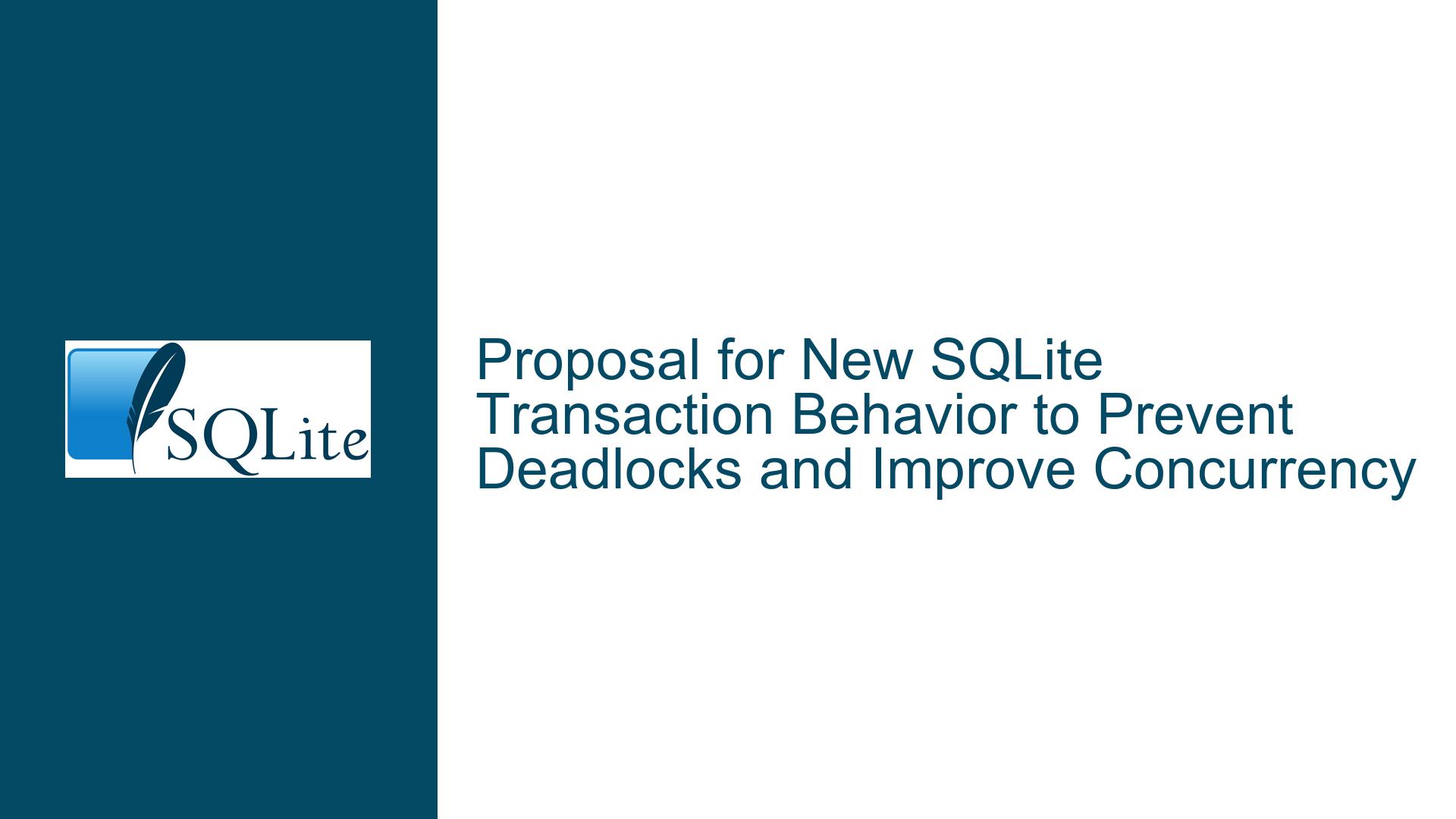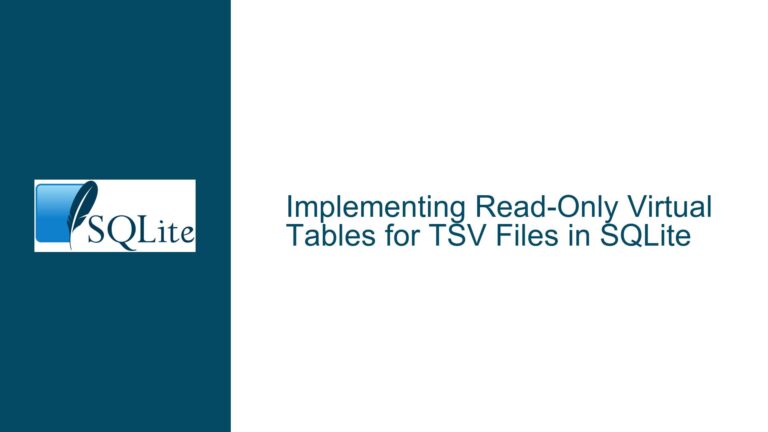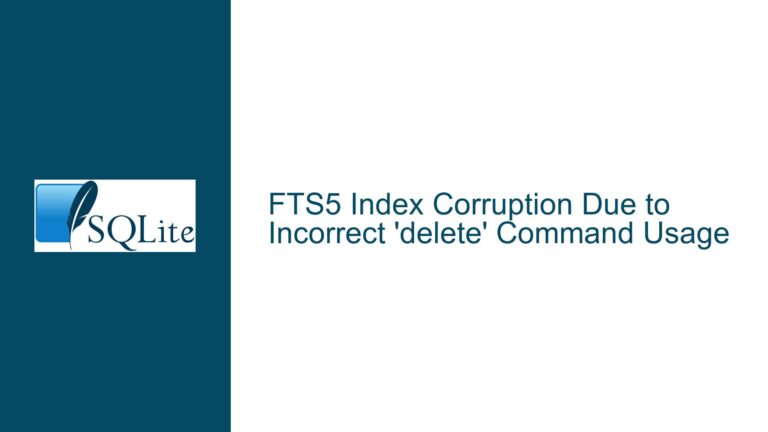Proposal for New SQLite Transaction Behavior to Prevent Deadlocks and Improve Concurrency
Issue Overview: Deadlocks and Concurrency in SQLite Transactions
SQLite, being a lightweight, serverless, and embedded database, is widely used in applications ranging from mobile apps to desktop software. However, its transaction handling mechanism, particularly with DEFERRED transactions, has been a point of contention among developers. The core issue revolves around how SQLite handles lock acquisition and deadlock scenarios, especially when multiple transactions attempt to write to the database concurrently.
In SQLite, transactions can be started in three modes: DEFERRED, IMMEDIATE, and EXCLUSIVE. DEFERRED transactions are the default and only acquire a lock when a write operation is initiated. This can lead to scenarios where two transactions, A and B, both start as DEFERRED, and when they attempt to escalate their locks to write, a deadlock occurs. Transaction A might hold a read lock, while Transaction B attempts to acquire a write lock, resulting in SQLITE_BUSY being returned. This behavior forces the application to handle retries, which can be cumbersome and error-prone.
The proposal in the discussion suggests a new transaction type or behavior where, instead of returning SQLITE_BUSY immediately, SQLite would automatically release the lock held by Transaction A, allowing Transaction B to complete its write operation. Transaction A would then retry acquiring the lock up to a specified timeout. This approach aims to eliminate deadlocks and reduce the burden on the application to handle retries.
However, this proposal raises concerns about data consistency. If Transaction A reads data, computes changes based on that data, and then attempts to write, but Transaction B modifies the same data in the meantime, the changes computed by Transaction A might no longer be valid. This is a classic problem in database systems known as the "stale data problem," where a transaction operates on outdated information, leading to inconsistent results.
Possible Causes: Why Deadlocks and Stale Data Occur in SQLite
The root cause of deadlocks in SQLite lies in its locking mechanism and the default DEFERRED transaction mode. When a transaction starts in DEFERRED mode, it does not acquire any locks initially. It only acquires a shared lock when it performs a read operation and attempts to escalate to an exclusive lock when it performs a write operation. This deferred locking strategy is designed to maximize concurrency by allowing multiple readers to access the database simultaneously. However, it also creates a window of opportunity for deadlocks when two transactions attempt to escalate their locks to write.
For example, consider two transactions, A and B, both starting in DEFERRED mode. Transaction A reads some data and holds a shared lock. Transaction B also reads the same data and holds a shared lock. When Transaction A attempts to write, it tries to escalate its lock to an exclusive lock but is blocked by Transaction B’s shared lock. Similarly, Transaction B is blocked by Transaction A’s shared lock when it attempts to write. This mutual blocking results in a deadlock, and SQLite returns SQLITE_BUSY to one of the transactions, forcing the application to handle the retry.
The stale data problem arises when a transaction reads data that is subsequently modified by another transaction before the first transaction commits. In SQLite, if Transaction A reads data and computes changes based on that data, but Transaction B modifies the same data before Transaction A commits, the changes made by Transaction A might be based on outdated information. This can lead to inconsistent results, especially in scenarios where the order of operations matters, such as financial transactions or inventory management.
The proposal to automatically release locks and retry acquiring them introduces a new set of challenges. While it might reduce the frequency of deadlocks, it does not address the stale data problem. If Transaction A releases its lock to allow Transaction B to complete, and then retries its write operation, it might overwrite changes made by Transaction B, leading to data inconsistency. This is particularly problematic in scenarios where the order of operations is critical, such as logging or event sequencing.
Troubleshooting Steps, Solutions & Fixes: Addressing Deadlocks and Stale Data in SQLite
To address the issues of deadlocks and stale data in SQLite, several strategies can be employed, ranging from changes in transaction handling to application-level modifications. Below, we explore these strategies in detail, along with their implications and trade-offs.
1. Using IMMEDIATE Transactions by Default
One of the simplest solutions to avoid deadlocks is to use IMMEDIATE transactions instead of DEFERRED transactions. IMMEDIATE transactions acquire a reserved lock as soon as the transaction begins, preventing other transactions from acquiring a write lock. This ensures that only one transaction can write to the database at a time, reducing the likelihood of deadlocks.
However, using IMMEDIATE transactions by default has its drawbacks. It reduces concurrency, as only one transaction can hold a reserved lock at a time. This can lead to performance degradation in scenarios with high write contention. Additionally, IMMEDIATE transactions do not completely eliminate the risk of deadlocks, as they can still occur if multiple transactions attempt to escalate their locks to exclusive.
To implement IMMEDIATE transactions by default, applications can modify their code to explicitly start transactions in IMMEDIATE mode using the BEGIN IMMEDIATE statement. Alternatively, a pragma such as pragma transaction_default=immediate can be used to set the default transaction mode to IMMEDIATE. This approach is particularly useful in frameworks or libraries that do not allow specifying the transaction mode directly.
2. Implementing Application-Level Retry Logic
Another approach to handling deadlocks is to implement retry logic at the application level. When a transaction encounters a SQLITE_BUSY error, the application can catch the error, wait for a short period, and then retry the transaction. This approach allows the application to handle deadlocks gracefully without requiring changes to the SQLite library.
However, implementing retry logic at the application level can be complex and error-prone. The application must ensure that the retry logic does not lead to infinite loops or excessive waiting. Additionally, the application must handle the stale data problem by re-reading the data and recomputing the changes before retrying the transaction.
To implement retry logic, applications can use a loop that retries the transaction a specified number of times before giving up. The loop should include a delay between retries to allow other transactions to complete. The delay can be fixed or exponential, depending on the application’s requirements.
3. Introducing a New Transaction Type with Automatic Retry
The proposal to introduce a new transaction type with automatic retry is an interesting solution to the deadlock problem. This new transaction type would automatically release its lock when it encounters a SQLITE_BUSY error, allowing the other transaction to complete. The transaction would then retry acquiring the lock up to a specified timeout.
However, as discussed earlier, this approach does not address the stale data problem. If Transaction A releases its lock to allow Transaction B to complete, and then retries its write operation, it might overwrite changes made by Transaction B. To mitigate this risk, the new transaction type could include a mechanism to detect changes to the data and abort the transaction if the data has been modified.
Implementing this new transaction type would require changes to the SQLite library, including modifications to the locking mechanism and the addition of new transaction modes. This approach would also require careful testing to ensure that it does not introduce new bugs or performance issues.
4. Using EXCLUSIVE Transactions for Critical Operations
For critical operations where data consistency is paramount, EXCLUSIVE transactions can be used. EXCLUSIVE transactions acquire an exclusive lock as soon as the transaction begins, preventing other transactions from reading or writing to the database. This ensures that only one transaction can access the database at a time, eliminating the risk of deadlocks and stale data.
However, using EXCLUSIVE transactions has significant drawbacks. It severely reduces concurrency, as only one transaction can access the database at a time. This can lead to performance degradation in scenarios with high contention. Additionally, EXCLUSIVE transactions are not suitable for long-running operations, as they can block other transactions for extended periods.
To use EXCLUSIVE transactions, applications can modify their code to explicitly start transactions in EXCLUSIVE mode using the BEGIN EXCLUSIVE statement. This approach should be reserved for critical operations where data consistency is more important than concurrency.
5. Leveraging SQLite’s WAL Mode
SQLite’s Write-Ahead Logging (WAL) mode is another solution to improve concurrency and reduce the likelihood of deadlocks. In WAL mode, writes are appended to a separate log file, allowing readers to continue accessing the database without being blocked by writers. This improves concurrency and reduces the likelihood of deadlocks, as readers and writers do not block each other.
However, WAL mode has its limitations. It requires additional configuration and may not be suitable for all use cases. Additionally, WAL mode does not completely eliminate the risk of deadlocks, as they can still occur if multiple transactions attempt to write to the same data.
To enable WAL mode, applications can use the pragma journal_mode=WAL statement. This approach is particularly useful in scenarios with high read contention, as it allows readers to access the database without being blocked by writers.
6. Implementing Optimistic Concurrency Control
Optimistic Concurrency Control (OCC) is a strategy that allows multiple transactions to proceed without acquiring locks, assuming that conflicts are rare. When a transaction commits, it checks for conflicts and aborts if any are detected. This approach reduces the likelihood of deadlocks and improves concurrency, as transactions do not block each other.
However, OCC requires careful implementation to ensure data consistency. The application must detect conflicts and handle them appropriately, either by retrying the transaction or by notifying the user. Additionally, OCC is not suitable for scenarios with high contention, as the likelihood of conflicts increases with the number of concurrent transactions.
To implement OCC, applications can use a versioning mechanism to detect conflicts. Each row in the database can include a version number, which is incremented on each update. When a transaction commits, it checks the version number of the rows it modified. If the version number has changed, the transaction aborts and retries.
Conclusion
Deadlocks and stale data are common challenges in SQLite, particularly when using DEFERRED transactions. While the proposal to introduce a new transaction type with automatic retry is an interesting solution, it does not address the stale data problem and requires changes to the SQLite library. Instead, developers can employ several strategies to mitigate these issues, including using IMMEDIATE transactions, implementing application-level retry logic, leveraging SQLite’s WAL mode, and using EXCLUSIVE transactions for critical operations.
Each of these strategies has its trade-offs, and the best approach depends on the specific requirements of the application. By understanding the underlying causes of deadlocks and stale data, developers can make informed decisions and implement solutions that balance concurrency, performance, and data consistency.






